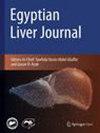Validity of serum resistin level and Il-6 as prognostic biomarkers of decompensated liver cirrhosis in chronic hepatitis C virus patients
IF 0.8
Q4 GASTROENTEROLOGY & HEPATOLOGY
引用次数: 0
Abstract
Abstract Background Decompensated liver cirrhosis (DLC) is now known as a chronic inflammatory process, evidenced by elevated levels of circulatory pro-inflammatory cytokines and chemokines which in turn lead to the development of more hepatic decompensation and multi-organ failure. Resistin has a pro-inflammatory effect through the production of several cytokines (e.g., IL-1, IL-6, IL-12, and TNF-α) and cell adhesion molecules. Interleukin-6 (IL-6) is a proinflammatory cytokine playing a crucial role in acute phase responses and in regulating immune reactions through activation and differentiation of T and B lymphocytes. The current study aimed to evaluate the value of serum resistin and IL-6 as biomarkers of DLC and their role as prognostic markers of complications in these patients. Results This study was conducted on 90 patients divided into three groups: group I—30 patients with compensated cirrhosis (CLC); group II—40 patients with DLC; and group III consisted of 20 healthy controls. Serum resistin and IL-6 levels were statistically significantly higher in patients with DLC compared to patients with CLC at baseline. A cut-off value of > 302 pg/ml for serum resistin was found to discriminate between CLC and DLC with a specificity of 73.33% and sensitivity of 92.50% and a cut-off level of > 31 pg/mL for IL-6 differentiated between the two groups with a sensitivity of 85.0% and specificity of 76.67%. Patients with DLC were followed up for 3 months, 10 patients (25%) passed away, and 19 patients out of the remaining 30 (63.3%) patients developed complications including acute kidney injury, spontaneous bacterial peritonitis, variceal hemorrhage, encephalopathy, and hepatocellular carcinoma. Serum resistin and IL-6 were found to be significantly higher at baseline in those patients who developed complications or mortality after the follow-up period. In addition, there were positive correlations between IL-6 and resistin and MELD-NA and CRP. Conclusion Serum resistin and IL-6 could be used as sensitive diagnostic and prognostic biomarkers of decompensated cirrhotic patients.血清抵抗素水平和Il-6作为慢性丙型肝炎患者失代偿性肝硬化预后生物标志物的有效性
失代偿性肝硬化(DLC)现在被认为是一种慢性炎症过程,循环促炎细胞因子和趋化因子水平升高,进而导致更多的肝脏失代偿和多器官衰竭。抵抗素通过产生多种细胞因子(如IL-1、IL-6、IL-12和TNF-α)和细胞粘附分子具有促炎作用。白细胞介素-6 (IL-6)是一种促炎细胞因子,通过激活和分化T淋巴细胞和B淋巴细胞,在急性期反应和调节免疫反应中发挥重要作用。本研究旨在评估血清抵抗素和IL-6作为DLC生物标志物的价值及其作为这些患者并发症预后标志物的作用。结果本研究将90例患者分为三组:I-30组代偿性肝硬化(CLC)患者;II-40例DLC患者;第三组为20名健康对照。DLC患者的血清抵抗素和IL-6水平在基线时明显高于CLC患者。截断值>302 pg/ml血清抵抗素可区分CLC和DLC,特异性为73.33%,敏感性为92.50%,截止水平为>31 pg/mL IL-6在两组间的差异,敏感性为85.0%,特异性为76.67%。DLC患者随访3个月,死亡10例(25%),剩余30例患者中出现急性肾损伤、自发性细菌性腹膜炎、静脉曲张出血、脑病、肝细胞癌等并发症19例(63.3%)。在随访期后出现并发症或死亡的患者中,血清抵抗素和IL-6在基线时明显升高。IL-6与抵抗素、MELD-NA、CRP呈正相关。结论血清抵抗素和白细胞介素-6可作为肝硬化失代偿患者诊断和预后的敏感生物标志物。
本文章由计算机程序翻译,如有差异,请以英文原文为准。
求助全文
约1分钟内获得全文
求助全文

 求助内容:
求助内容: 应助结果提醒方式:
应助结果提醒方式:


